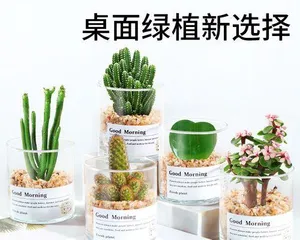Abstract:
Baby's Breath (Botanical name: Gypsophila paniculata) is a beautiful potted flower. Its small flowers and slender stems create a beautiful landscape, like a sky full of stars. However, to ensure that Baby's Breath potted flowers grow for a long time and remain in good condition, we need to master some care techniques and precautions.

One: Choosing the Right Pot and Soil
Choosing the right pot is very important for the growth of Baby's Breath. We can choose a ceramic or plastic pot with a diameter of about 20 cm to facilitate drainage. The soil should be loose, fertile, and well-aerated, such as leaf mold or peat soil, to ensure normal respiration of the Baby's Breath roots.
Two: Watering Rationally and Controlling Humidity
Baby's Breath likes a humid environment, but too much water can cause its roots to rot. When watering, it is necessary to avoid waterlogging and keep the soil moist but not soggy. Generally, watering once a week is sufficient. In summer, the frequency of watering can be appropriately increased. You can also spray water around to increase air humidity.

Three: Providing Suitable Light Conditions
Baby's Breath is a sun-loving plant that likes plenty of sunlight. We should place the Baby's Breath potted flower in a bright location with suitable light intensity. Avoid prolonged exposure to strong sunlight to prevent leaf scorch.
Four: Paying Attention to Temperature Control
The suitable temperature range for Baby's Breath to grow is 15°C-25°C. Temperatures that are too low or too high will affect its growth. In cold winter, we need to move the Baby's Breath indoors or take insulation measures. In summer, you can adjust the ambient temperature or increase ventilation.
Five: Regular Fertilization
Baby's Breath needs a sufficient supply of nutrients during its growth period, so we need to fertilize regularly. Generally, apply a mature organic fertilizer once a month. You can also choose a liquid fertilizer containing elements such as nitrogen, phosphorus, and potassium for top dressing. But be careful not to over-fertilize, as it may cause the potted flower to grow too vigorously, affecting its overall beauty.

Six: Pruning and Deadheading
Regularly pruning the branches and leaves of Baby's Breath can keep its shape neat and promote the growth of lateral buds. At the same time, removing withered flowers helps the plant concentrate its energy on new flowers and growth, extending the flowering period.
Seven: Preventing and Controlling Pests and Diseases
Baby's Breath potted flowers are relatively resistant to pests and diseases, but preventive work is still necessary. Regularly check the leaves and stems of the plant for the presence of pests such as aphids or spider webs, and take corresponding control measures in time, such as spraying insecticides or wiping the leaves.
Eight: Avoiding Drought and Over-hydration
Baby's Breath has certain requirements for soil moisture; it cannot be too dry or too wet. When watering, pay attention to controlling the appropriate amount of water to avoid causing root hypoxia or rot.
Nine: Adjusting Light and Temperature with the Seasons
As the seasons change, the light and temperature requirements of Baby's Breath will also change. In spring and autumn, you can appropriately increase light and temperature to create a more suitable growth environment. In winter and summer, pay attention to keeping warm and cooling down to avoid damage to the plant from temperatures that are too high or too low.
Ten: Proper Support and Staking
The branches of Baby's Breath potted flowers are long and fragile during the growth period, and are prone to lodging or breaking. To maintain its good shape, you can use supports such as wooden sticks or bamboo to support and secure it, preventing the branches from bending or breaking.
Eleven: Timely Repotting and Soil Renewal
After growing for a period of time, Baby's Breath will gradually consume the nutrients in the soil, so it needs to be repotted and the soil renewed in a timely manner. Generally, repot the Baby's Breath into a new pot and replace the soil every 2-3 years to ensure its normal growth and flowering.
Twelve: Choosing a Suitable Indoor Environment
Baby's Breath potted flowers are also suitable for indoor placement, adding greenery and vitality to the indoor environment. Choose a bright location but avoid direct, strong sunlight. Reasonably control indoor temperature and humidity, and provide appropriate light and air circulation to allow Baby's Breath to grow healthily indoors.
Thirteen: Paying Attention to Seasonal Dormancy
In the natural growth process, Baby's Breath has a need for seasonal dormancy. It generally enters a dormant period in autumn. At this time, watering and fertilization should be reduced, and it should be moved to a cooler place to avoid the effects of high temperature and humidity.
Fourteen: Pairing with Other Plants
Baby's Breath potted flowers can not only be planted alone but can also be paired with other plants. You can choose tall plants as a background to make the Baby's Breath more prominent, or you can combine it with other plants with similar flower colors to create a more splendid landscape.
Fifteen: The Enduring Beauty of Baby's Breath Potted Flowers
Through proper care methods and meticulous management, we can keep Baby's Breath potted flowers beautiful for a long time. Reasonably control water, light, temperature, and fertilization; prune and control pests and diseases in a timely manner; and choose suitable pots and soil. Baby's Breath potted flowers can become a highlight in your home or office, bringing endless joy and appreciation.
Through the detailed introduction of the care guide for Baby's Breath potted flowers, we can understand that caring for Baby's Breath requires attention to selecting suitable pots and soil, rational watering and humidity control, providing suitable light and temperature, regular fertilization and pruning, and preventing and controlling pests and diseases. Only by comprehensively considering these factors and operating correctly can we ensure that Baby's Breath potted flowers maintain healthy growth for a long time and bloom into a charming starry sky.